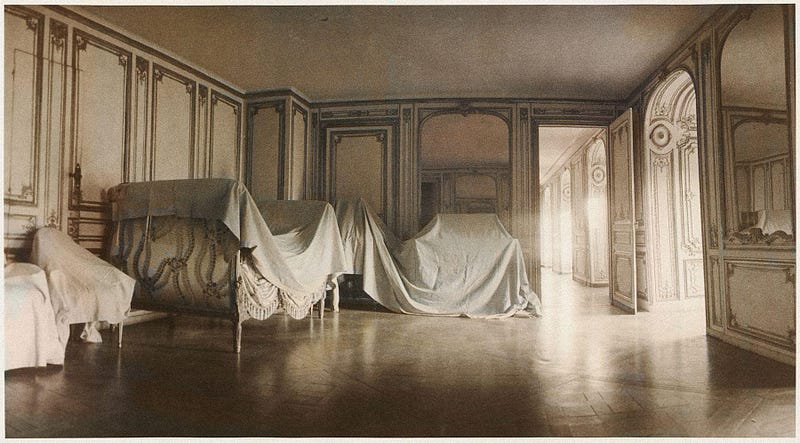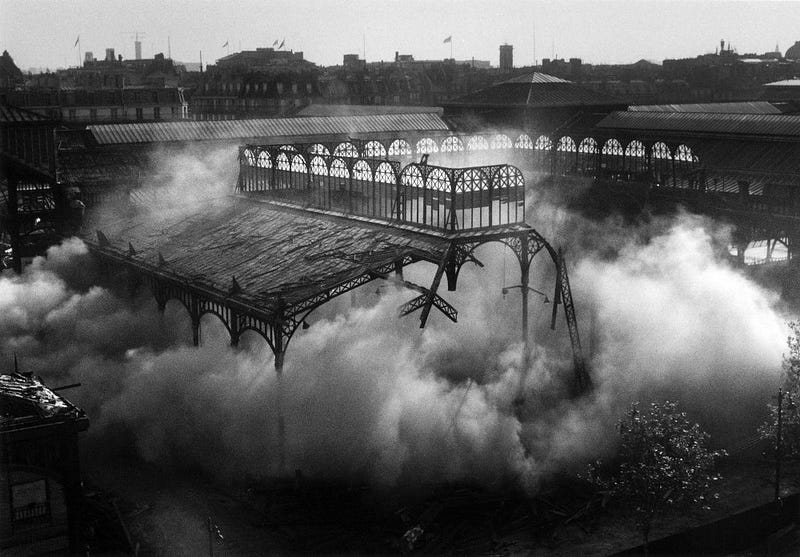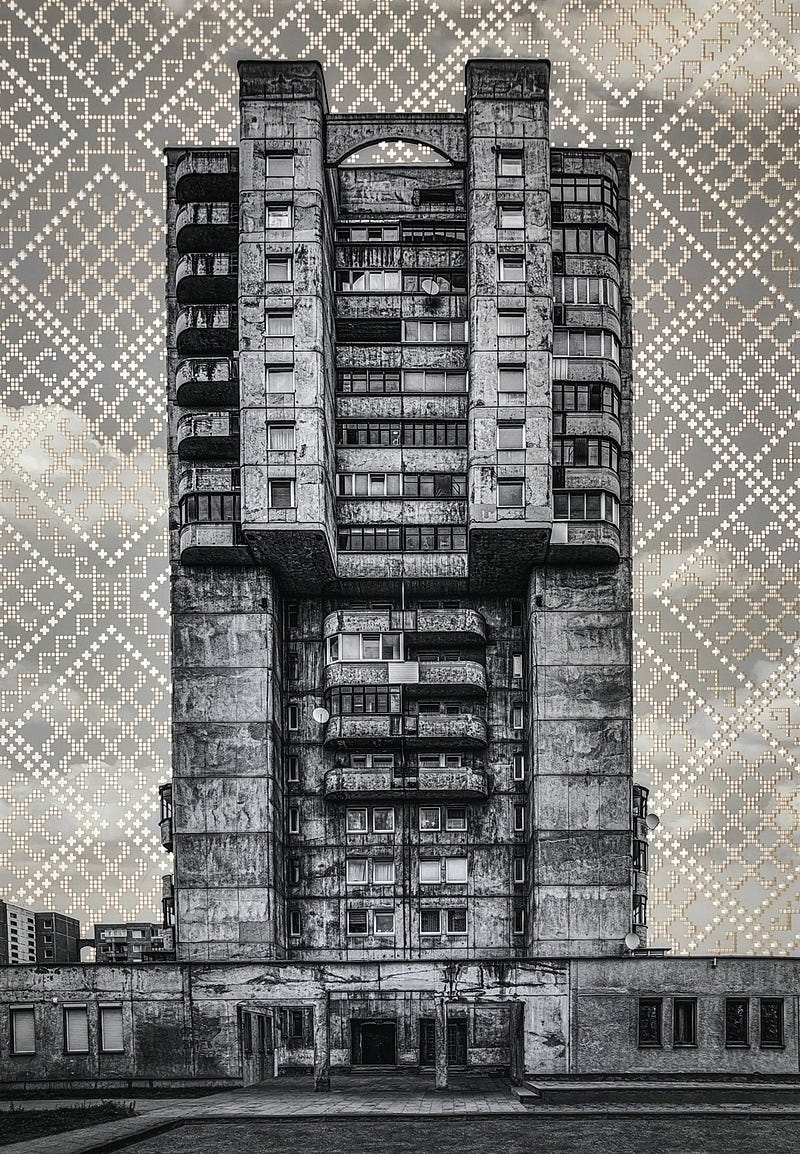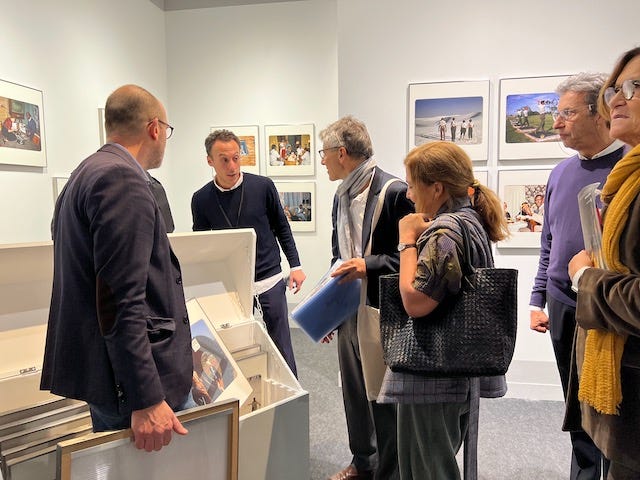Paris Photo, Days 3 & 4: Places
Where dreams go to die, and be born

Agog: what happens inside the viewer when the concept, the composition, and the colors all mesh. As in, I’m all agog. As in, Don’t stagger; you’ll crash into someone and embarrass yourself.
The photo above was wrangled and created by Eugenio Ampudia, the Spanish photographer. At the end of the COVID lockdown he organized a concert for 2,292 plants in El Liceu Teatre, Barcelona: the number that would fill the theater seats. The string quartet played Puccini’s “Crisantemi.” You can watch a video of the action on the artist’s website. He did a series of five photographs, the majesty of which the reproduction above cannot adequately convey. The viewer staggers, indeed: the size, the colors, the beauty of the setting — the plants!
I found myself shuttling between two kinds of *wow* reactions at Paris Photo this year: one, to my favorite classic black and white photos, often vintage, but sometimes recent; two, to this kind of out-of-the-world scale of work, often in vivid color. I also found that I was newly drawn to mixed media productions, sometimes of the mischievous, scribble-on-the-print or create an unexpected 3-D effect variety.

Deborah Turbeville, an innovative photographer who died in 2013 at 81, started out as a fashion editor, and throughout her long career pushed the edges of conventional fashion photography and explored the places people had lived — lived and perhaps abandoned: Versailles, Newport, stairwells, greenhouses, and so on. The spooky draped furniture at Versailles, above, is far from the touristic route through the glittering monument.

I have no idea why I want to stroll through the alley between these buildings, captured by the Italian photographer Niccolò Montesi. Maybe it’s the faint, modulated green glow on the far building where the sun hits it slantwise. The geometrical perfection, underlined by the vertical lines of the buildings, the doors, the windows, just grabs the viewer, as do the muted colors. The angles are sharp and perfect, unlike the details of the buildings themselves. Talk about a vanishing point.

After the official decision to move most of Paris’s daily food market to Rungis on the outskirts of the city, the grand complex of les Halles, at the heart of the city (and its stomach, as Zola wrote) was torn down. The beautiful iron and glass structures designed by Victor Baltard were destroyed (with two exceptions, shipped and rebuilt out of the city) and, as with Penn Station in New York, they were replaced with grossly inferior buildings and a tacky mall-cum-public park. Ick. (And let’s not get started on Châtelet-Les Halles, the huge rail station under the mall.)
The photographer Jean-Claude Gautrand was one of the many who deplored the “renovation,” and he was there to record the heartbreaking and awe-inspiring planned disaster that was the deconstruction. There are two representative prints from the destruction (the assassination, as Gautrand had it) in Les Douches gallery’s booth — actually the whole sequence is worth looking at online.

It is impossible to see Krista Svalbonas’s work properly in two dimensions, alas. This is above and beyond mixed media, so elaborate is the construction of these images.
Svalbonas describes herself as ethnically Latvian/Lithuanian. Her parents followed a long, difficult road after World War II to migrate from displaced persons camps to the United States. Her photographs in the “What Remains” series express grief for the Soviet-era gutting of town centers, and the replacement of traditional architecture with shoddy structures. At the same time the delicate construction and decoration of the photos celebrates the population’s stubborn nourishing of Baltic art forms throughout the Soviet occupation. Svalbonas visited Latvia and Lithuania in the last few years and photographed some of the Soviet buildings that still stand. She then laser-cut traditional Baltic textile designs into the black and white prints.
All five of the artists I’ve chosen to discuss replicate some version of that mixture of sorrow and joy, mourning what is lost and celebrating the weird beauty of what remains. In some ways, Ampudia’s vision is the most grand and tragic. He sees the end of the Anthropocene, the human-dominated era that we have so royally fucked up, replaced by the biocene, in which plant life takes over the world. (I’ve oversimplified these concepts, but there you are.)
One can only hope in this time of despair. (Fiddle while the oil spills burn?)
Representing ‘place’ in a photograph can be done in so many ways. A great photograph of place tugs at our hearts (to be a bit clichéd). It goads our emotions and evokes memories and dreams.
I think that tomorrow, my last diary entry on Paris Photo will be ‘faces.’

And here are a few faces, absorbed in the buying and selling that is a huge part of this big show.
Here are the previous Paris Photo stories:
Thanks for being here!
